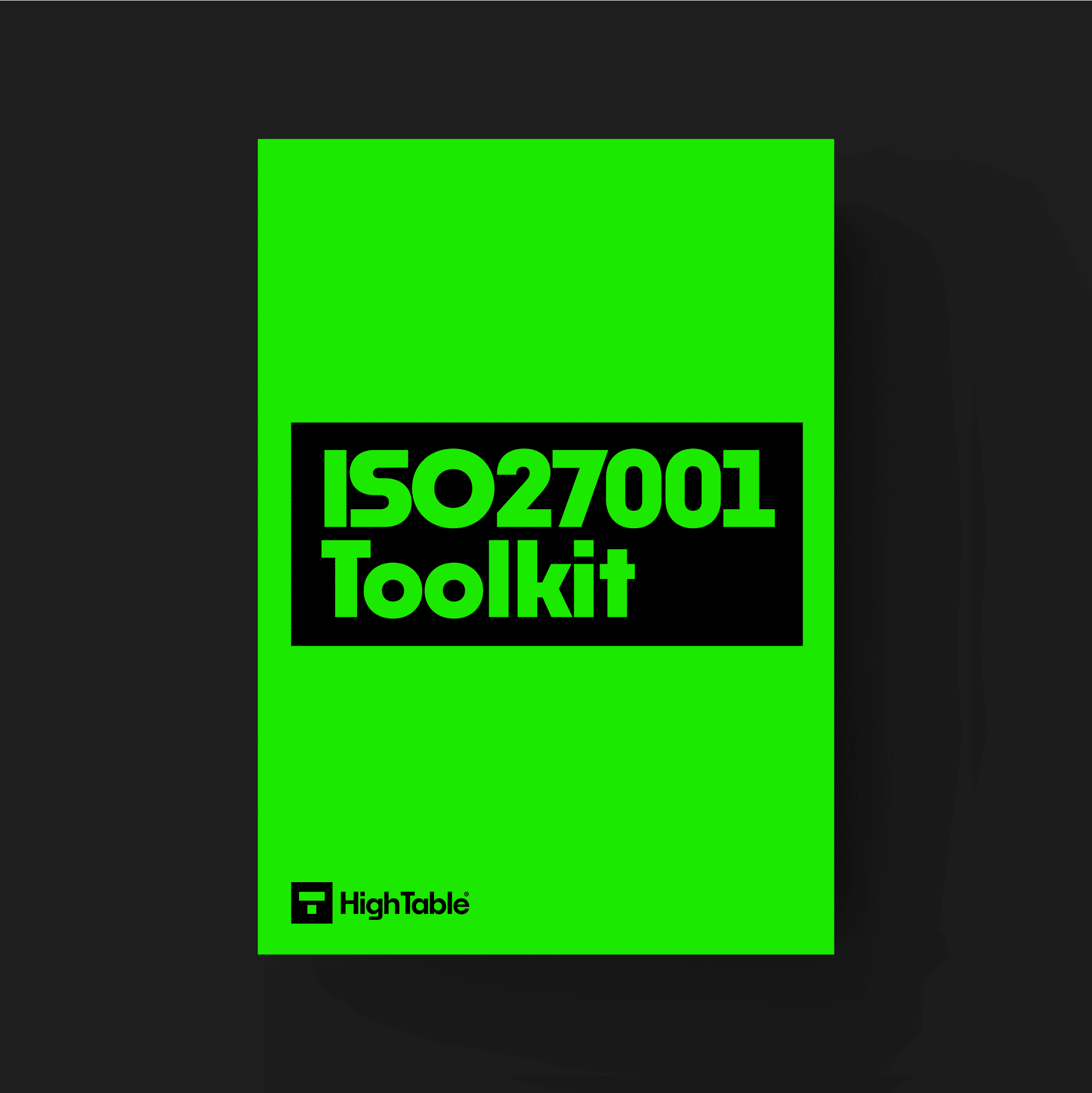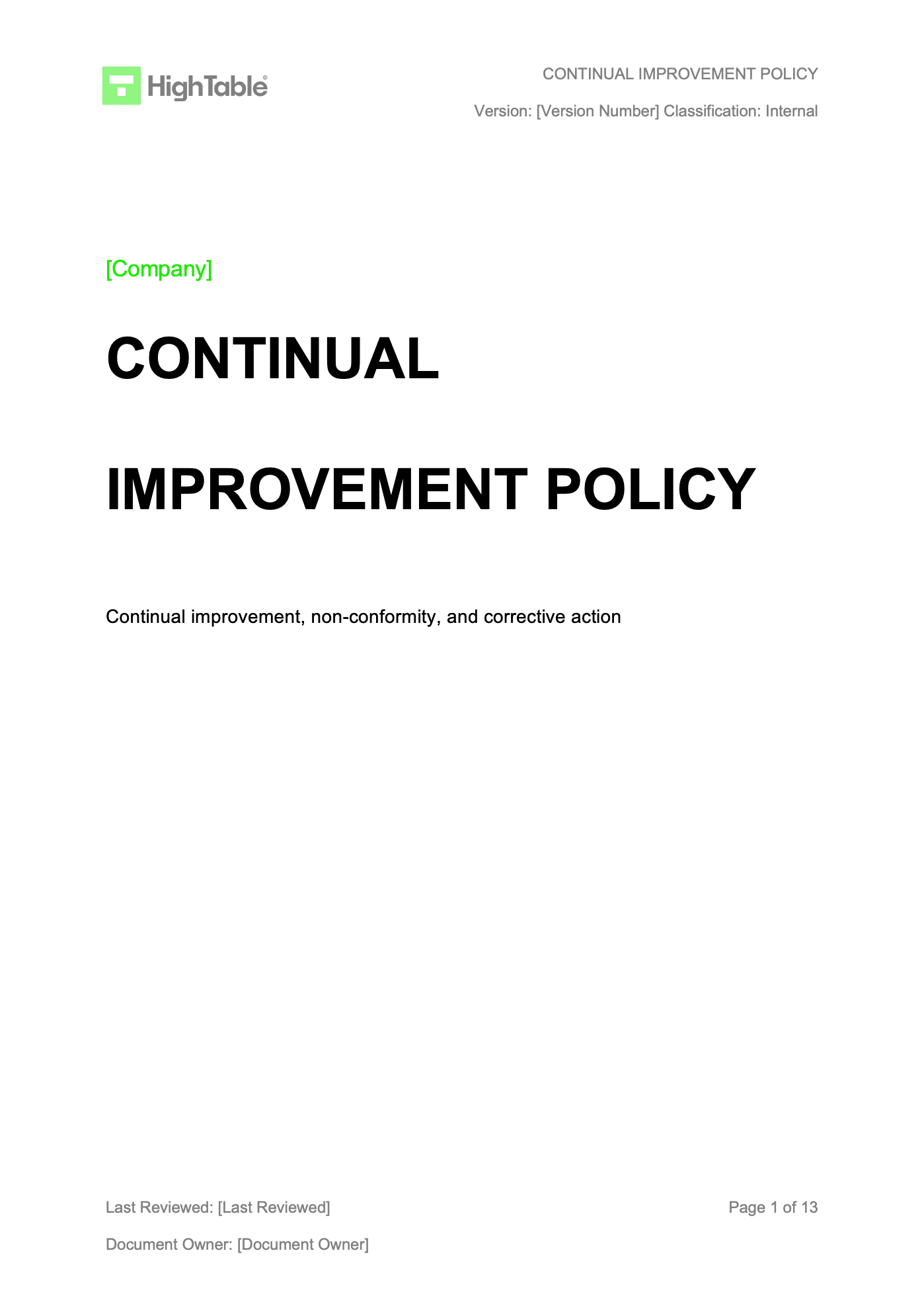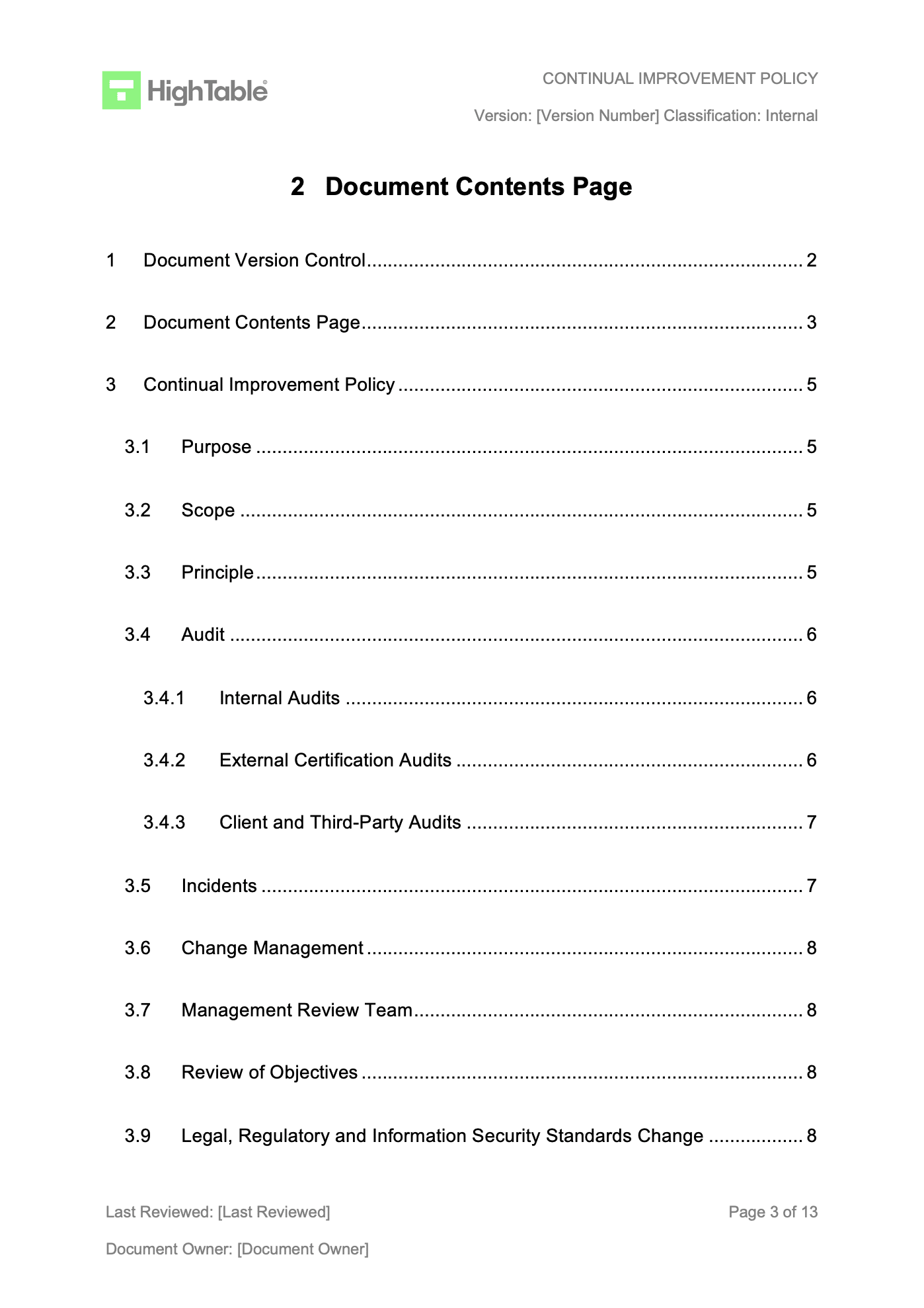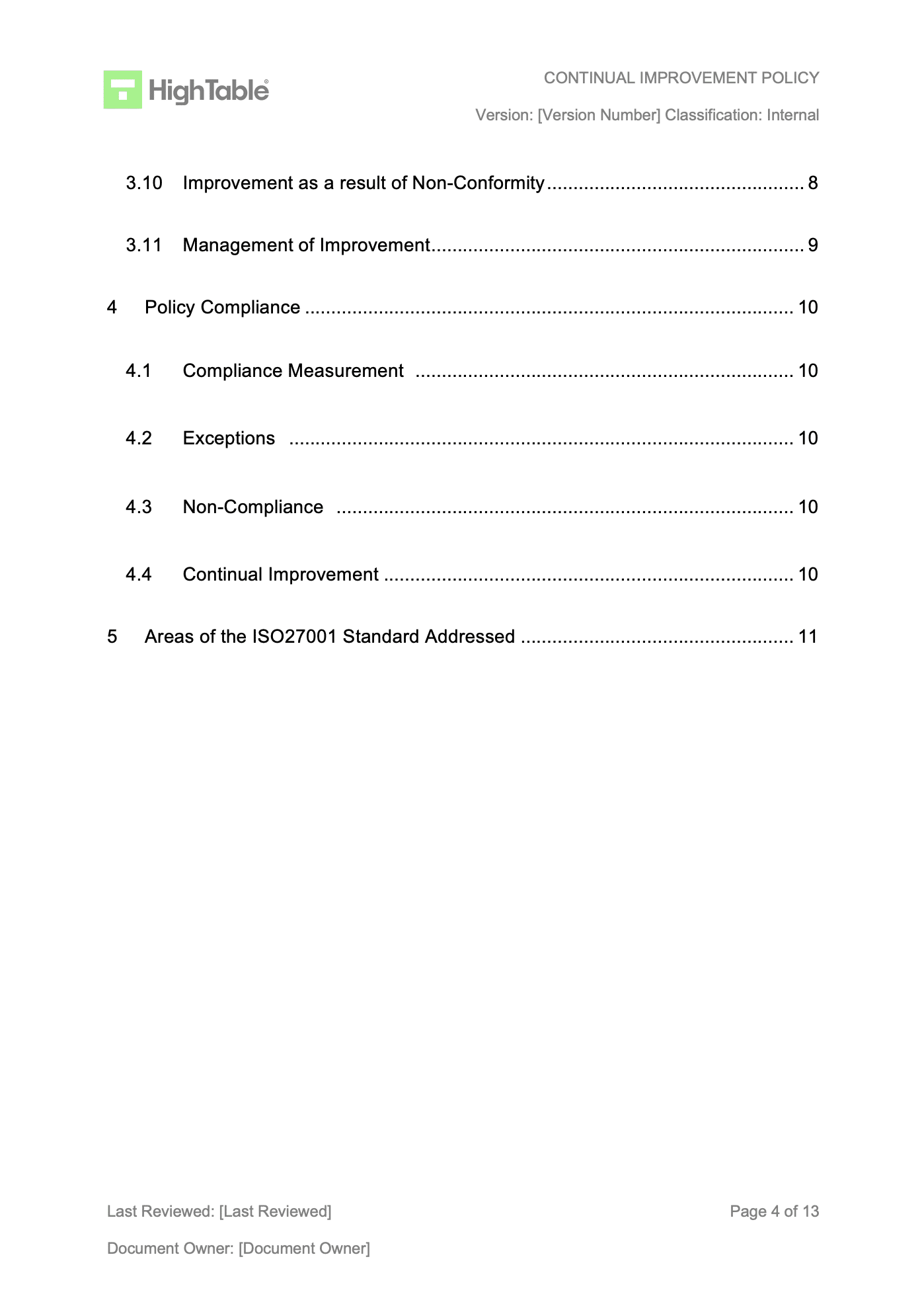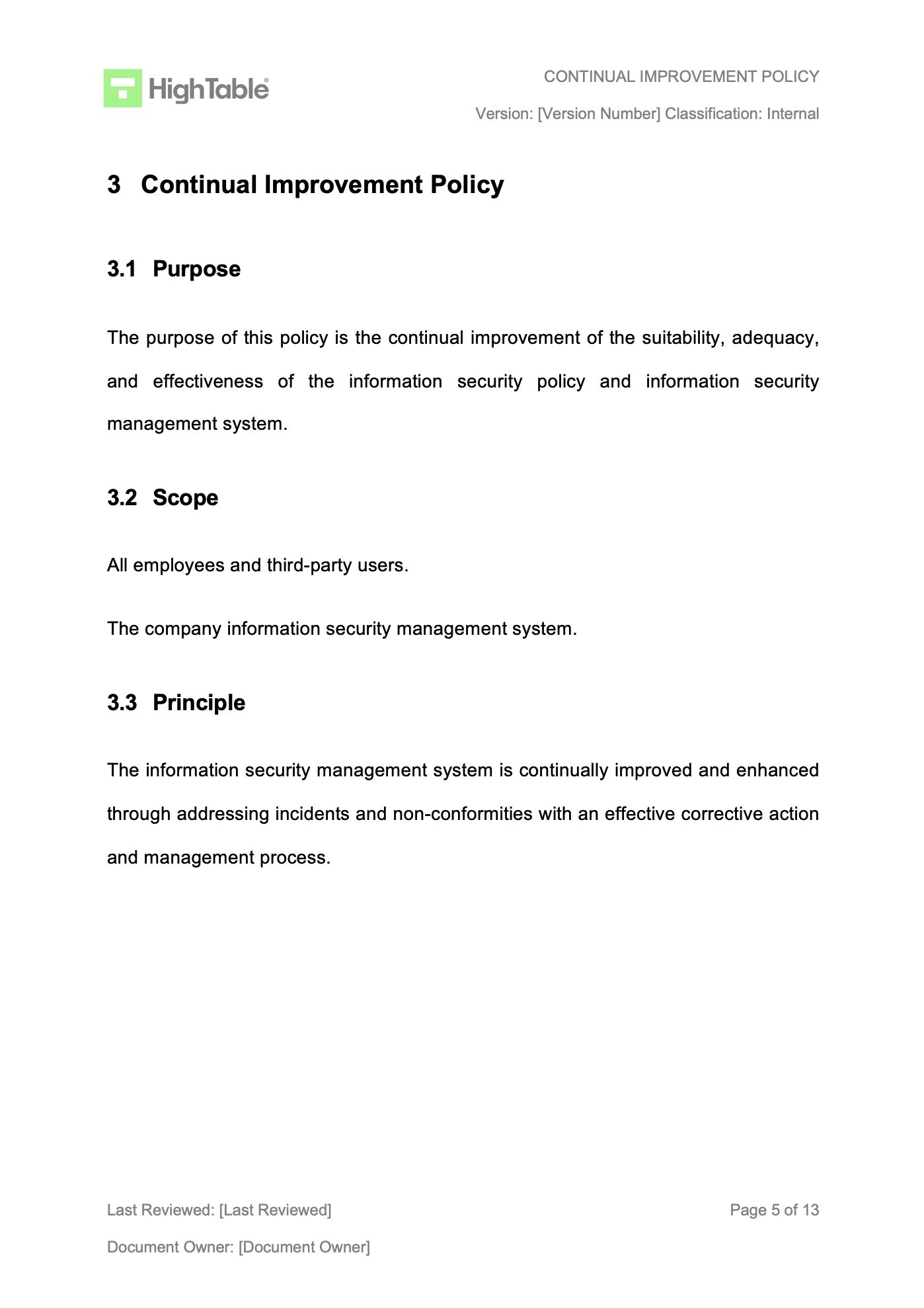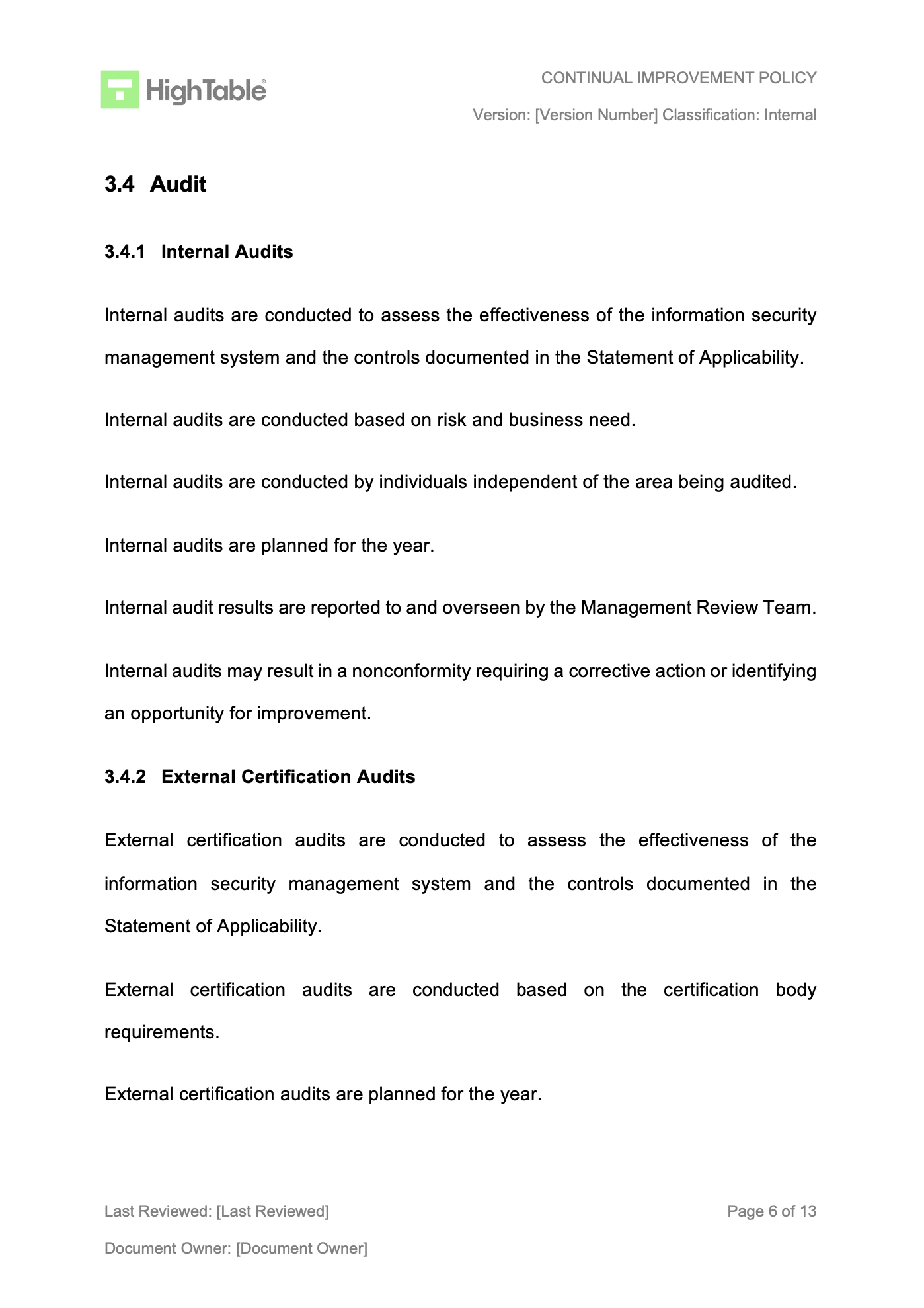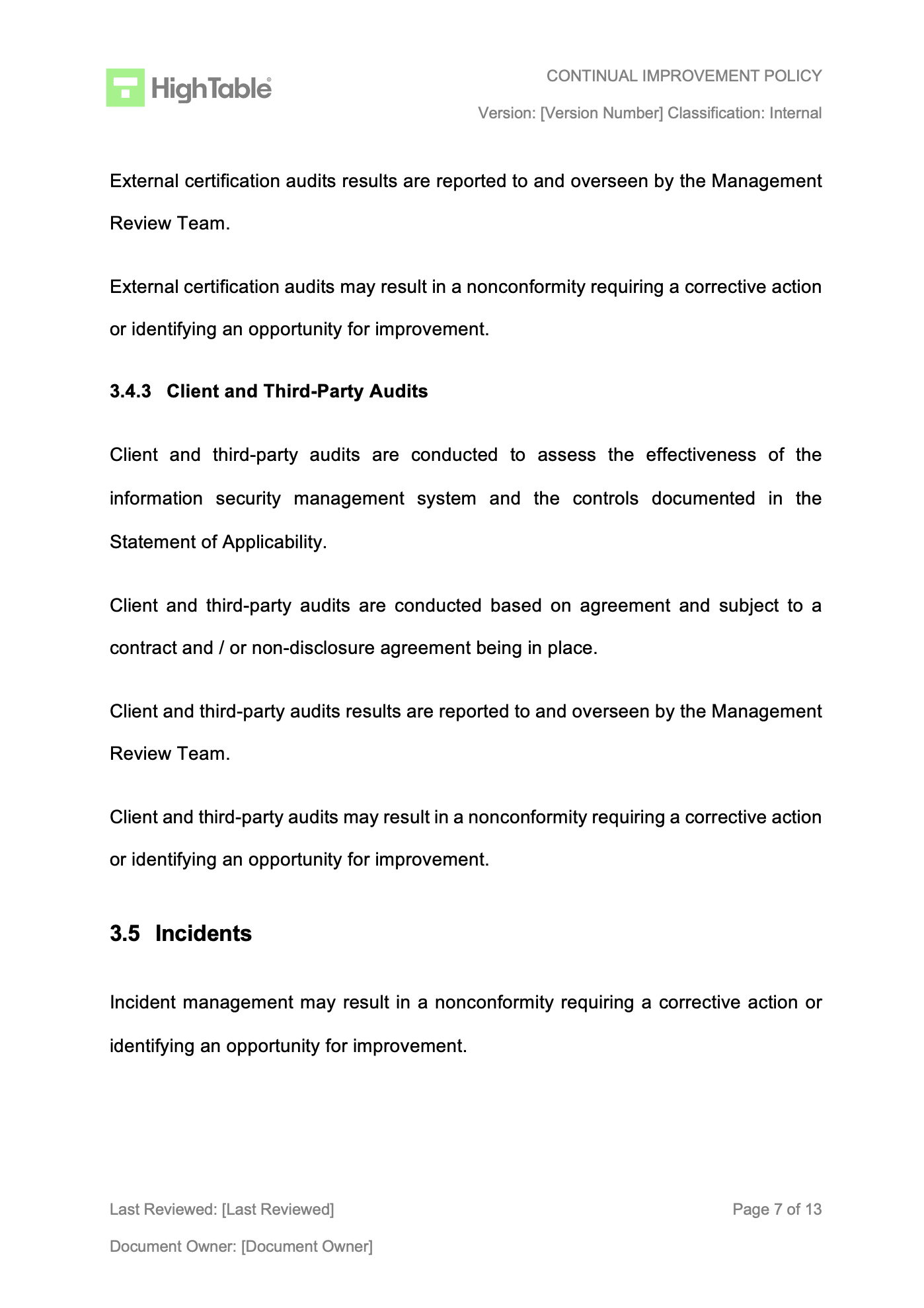A Continual Improvement Policy sets out the guidelines and the framework for how you manage when you identify that things are not working as intended. The policy is about maintaining an effective information security management system so it continues to meet is intended goals.
ISO 27001 acknowledges that things are not always perfect and advocates for continually improving.
Table of contents
- What is it?
- Applicability to Small Businesses, Tech Startups, and AI Companies
- ISO 27001 Continual Improvement Policy Template
- Why do you need it?
- When do you need it?
- Who needs it?
- Where do you need it?
- How to write it
- How to implement it
- Examples of using it for small businesses
- Examples of using it for tech startups
- Examples of using it for AI companies
- How the ISO 27001 toolkit can help
- Information security standards that need it
- List of relevant ISO 27001:2022 controls
- ISO 27001 Continual Improvement Policy Example
- ISO 27001 Continual Improvement Policy FAQ
What is it?
Think of a Continual Improvement Policy like a roadmap for making things better. It’s a key part of the ISO 27001 standard, which is all about keeping your information safe and secure. This policy is your promise to always look for ways to improve your security. It’s a way of saying, “We’re not just good enough; we’re always trying to get better.” It’s not a one-time thing; it’s a constant cycle of checking, fixing, and improving. You set goals, measure your progress, and then make changes based on what you learn.
Applicability to Small Businesses, Tech Startups, and AI Companies
This policy is useful for businesses of all sizes, including small businesses, tech startups, and AI companies.
- Small Businesses: You can keep it short and simple. Focus on one or two key areas to improve each year, like getting better at backing up data or training employees on spotting phishing emails.
- Tech Startups: Your policy should be flexible. As your company grows fast, your security needs will change. Your policy should reflect this, maybe by focusing on things like secure coding or managing new cloud services.
- AI Companies: You need to focus on protecting the data used to train your AI models. Your policy should include how you’ll keep this data safe and how you’ll make sure your AI systems are not misused.
ISO 27001 Continual Improvement Policy Template
The ISO 27001:2022 Continual Improvement Policy Template is part of the Ultimate ISO 27001 Toolkit and also exclusively available stand-alone. It is prewritten, fully populated and ready to go and fully complies with ISO27001:2022.
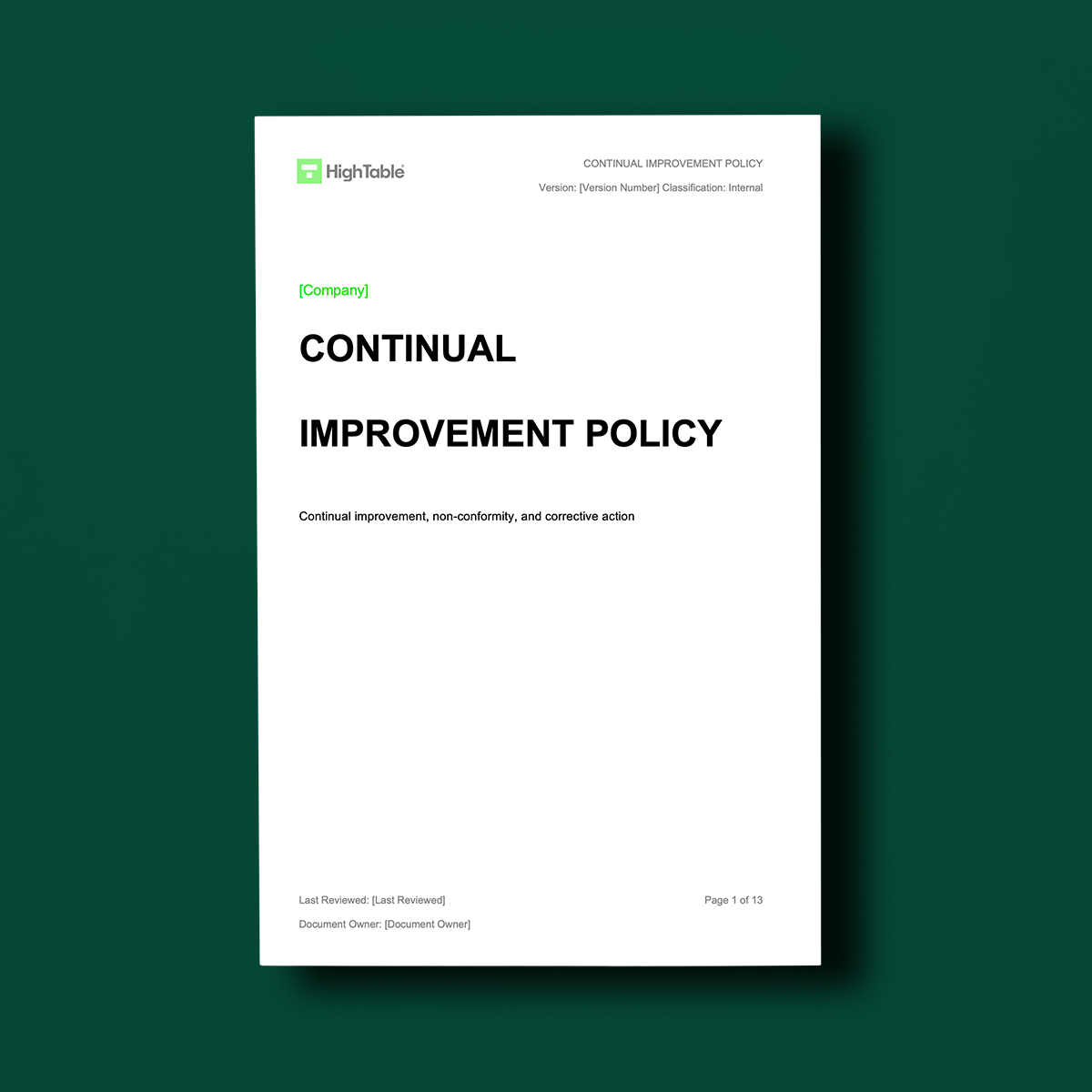
Why do you need it?
You need this policy to show you’re serious about security. It helps you stay ahead of new threats and fix problems before they get big. Plus, it’s a requirement for getting and keeping your ISO 27001 certification. Having this policy helps build trust with your customers and partners because it shows you’re committed to protecting their data.
When do you need it?
You need this policy right from the start when you begin your ISO 27001 journey. It’s one of the first things you’ll create as you build your Information Security Management System (ISMS). You’ll also need to review and update it regularly, especially after major changes to your business or new security risks pop up.
Who needs it?
Anyone who wants to get ISO 27001 certified needs this policy. This includes the person in charge of security, your IT team, and even the leadership of your company. It’s not just for a few people; it’s a commitment for the whole organisation. Everyone plays a part in making sure information stays safe.
Where do you need it?
You need this policy to be a central part of your company’s security documents. It should be easy for all your employees to find and understand. This policy is a formal document, so you should keep it in a secure, accessible place, like an internal shared drive or a document management system.
How to write it
Writing the policy is easy! Start by stating your company’s commitment to security. Then, list the different ways you’ll improve. This could include doing regular security reviews, looking at feedback from employees, and learning from any security incidents. Keep it simple and use clear language so everyone can understand it.
Time needed: 1 hour and 30 minutes
How to write an ISO 27001 Continual Improvement Policy
- Write the ISO 27001 Continual Improvement Policy Page
The contents of the continual improvement Policy should include:
Document Version Control
Document Contents Page
Continual Improvement Policy
Purpose
Scope
Principle
Audit
Internal Audits
External Certification Audits
Client and Third-Party Audits
Incidents
Change Management
Management Review Team
Review of Objectives
Legal, Regulatory and Information Security Standards Change
Improvement as a result of Non-Conformity
Management of Improvement
Policy Compliance
Compliance Measurement
Exceptions
Non-Compliance
Continual Improvement
Areas of the ISO27001 Standard Addressed - Write the ISO 27001 Continual Improvement Policy Purpose
Record the purpose of the policy. An example of the purpose is – the continual improvement of the suitability, adequacy, and effectiveness of the information security policy and information security management system.
- Write the ISO 27001 Continual Improvement Policy Scope
Scope is all employees and third party users and also the information security management system (ISMS).
- Write the ISO 27001 Continual Improvement Policy Principle
The principle is the information security management system is continually improved and enhanced through addressing incidents and non-conformities with an effective corrective action and management process.
- Describe how you perform internal audits
Internal audits are conducted to assess the effectiveness of the information security management system and the controls documented in the Statement of Applicability.
Internal audits are conducted based on risk and business need.
Internal audits are conducted by individuals independent of the area being audited.
Internal audits are planned for the year.
Internal audit results are reported to and overseen by the Management Review Team.
Internal audits may result in a nonconformity requiring a corrective action or identifying an opportunity for improvement. - Describe how you perform external audits
External certification audits are conducted to assess the effectiveness of the information security management system and the controls documented in the Statement of Applicability.
External certification audits are conducted based on the certification body requirements.
External certification audits are planned for the year.
External certification audits results are reported to and overseen by the Management Review Team.
External certification audits may result in a nonconformity requiring a corrective action or identifying an opportunity for improvement. - Describe how you perform client and third party audits audits
Client and third-party audits are conducted to assess the effectiveness of the information security management system and the controls documented in the Statement of Applicability.
Client and third-party audits are conducted based on agreement and subject to a contract and / or non-disclosure agreement being in place.
Client and third-party audits results are reported to and overseen by the Management Review Team.
Client and third-party audits may result in a nonconformity requiring a corrective action or identifying an opportunity for improvement. - Explain the role of information security incidents
Whilst you will have an incident management process and likely an incident management professional who can help here, our continual improvement policy is going to set out the role incidents play for continual improvement. An example:
Incident management may result in a nonconformity requiring a corrective action or identifying an opportunity for improvement. - Explain the role of change management
Change management will consider and may identify an opportunity for improvement.
- Set out the role of the Management Review Team
The management review team has an oversight role.
The management review team as part of the structured management review team agenda consider opportunities for improvement. - Document how the review of objectives contributes
The review of information security objectives will consider and may identify an opportunity for improvement.
- Explain the role Legal, Regulatory and Information Security Standards Changes
Changes as a result of legal and regulatory requirements or changes to applicable standards for information security will consider and may identify an opportunity for improvement.
- Describe Improvement as a result of Non-Conformity
A non-conformity is a deviation from the norm. This is defined as a deviation from policy and / or process.
Nonconformity to process or policy is identified by the audit process and the occurrence of incidents.
When a nonconformity occurs, action is taken to correct it and deal with the consequences.
Nonconformities are evaluated for the need to eliminate the causes of the non-conformity in order that it does not reoccur or occur elsewhere:
– Reviewing the non-conformity
– Determining the cause of the non-conformity
– Determining if similar nonconformities exist or could potentially occur.
Nonconformities are reported through the Management Review Team.
Nonconformities are recorded, documented, and tracked in the incident and corrective action log.
The effectiveness of corrective actions is reviewed. - Explain the Management of Improvement
Changes to the information security management system are planned and managed.
Changes to the information security management are recorded in the incident and corrective action log or in a change log, as appropriate and relevant. - Describe the process for policy compliance
Set how compliance with the policy will be measured and enforced.
How to implement it
Putting the policy into practice means making it a part of your daily work. This involves:
- Training: Teach your employees what the policy means and why it’s important.
- Regular reviews: Set a schedule to check your security controls.
- Reporting: Encourage everyone to report potential security issues.
- Action: When you find a problem, fix it and learn from it.
Examples of using it for small businesses
Your small online shop learns about a new type of online fraud. You use your policy to quickly update your website’s security and train your staff to recognise the threat.
Examples of using it for tech startups
Your company builds a new app. You find a minor bug that could be a security risk. Your policy guides you to fix the bug, test it, and update your development process so the bug doesn’t happen again.
Examples of using it for AI companies
You get feedback that one of your AI models is making biased decisions. Your policy helps you set up a process to review the model’s data, fix the bias, and improve your data collection methods for the future.
How the ISO 27001 toolkit can help
An ISO 27001 toolkit is a great shortcut. It comes with pre-made templates and guides for everything, including your Continual Improvement Policy. These toolkits take the guesswork out of writing and implementing your policies, making the whole process much faster and easier for you.
Information security standards that need it
This policy is a key part of ISO 27001, which is an international standard for managing information security. Other standards that need it include:
- GDPR (General Data Protection Regulation)
- CCPA (California Consumer Privacy Act)
- DORA (Digital Operational Resilience Act)
- NIS2 (Network and Information Security (NIS) Directive)
- SOC 2 (Service Organisation Control 2)
- NIST (National Institute of Standards and Technology)
- HIPAA (Health Insurance Portability and Accountability Act)
List of relevant ISO 27001:2022 controls
The ISO 27001:2022 standard has specific controls that relate to continual improvement:
- ISO 27001:2022 Clause 10.1 Continual Improvement
- ISO 27001:2022 Clause 10.2 Nonconformity and Corrective Action
ISO 27001 Continual Improvement Policy Example
This is a great example of the Continual Improvement Policy. Taking the first 3 pages being the contents of what it includes.
ISO 27001 Continual Improvement Policy FAQ
- What does continual improvement mean? It means you’re always looking for ways to get better at keeping information safe.
- Is this a legal document? No, it’s a company policy, but it helps you meet legal and regulatory requirements.
- Do I have to do this forever? Yes, it’s an ongoing process to maintain your security.
- Can I copy a policy from another company? It’s better to create your own, so it fits your unique needs.
- What happens if we don’t follow the policy? You could fail your ISO 27001 audit and lose your certification.
- How often should we review the policy? At least once a year, or whenever there are big changes.
- Who is responsible for the policy? The whole company, but a senior leader is usually in charge.
- What’s the difference between this and a security plan? The plan says what you will do now; the policy says you’ll always look to do better.
- Can we use a simple spreadsheet to track improvements? Yes! Use whatever works for you.
- Is this just for big companies? No, even the smallest company can benefit from getting better at security.
- What if we have a security breach? Your policy guides you on how to handle it and learn from it.
- Does this policy replace our security team? No, the security team uses this policy to guide their work.
- Is the policy public? No, it’s for internal use.
- How long should the policy be? A few pages is usually enough.
- Does it cost a lot to do this? The main cost is time and effort, not money.

